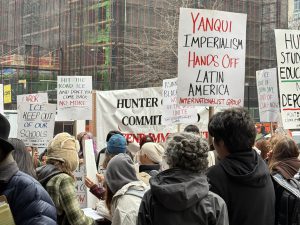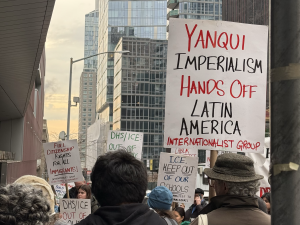

More than 150 students, faculty, staff, and activists gathered outside the John Jay College of Criminal Justice in protest against the Department of Homeland Security’s recruitment efforts at the school’s annual job fair in late February.
The protest, fueled by growing concerns over the presence of Immigration and Customs Enforcement and Customs and Border Protection agents, brought attention to the deep unease felt by many students, especially those from immigrant families. As the largest public university system in the United States, the City University of New York (CUNY) has long been a safe haven for immigrant students, and many fear that these recruiting efforts could not only militarize campuses but also put their communities at risk.
The protest was organized by Hunter Committee to Defend Immigrants, a student group founded by the CUNY Internationalist Group advocating for immigrant rights, and it drew students from across CUNY schools, including Hunter College. Protesters argue that DHS’s presence at the job fair sends a harmful message to immigrant students at CUNY, threatening to undermine the university’s role as a safe space for marginalized communities.

Grace Campbell, a 26-year-old student at Hunter College, voiced concerns about the impact of these recruitment efforts. “CUNY is a largely immigrant school and the largest public university in the country. So, having DHS/ICE recruiting here, especially during a time when mass deportations are happening, sends a message of fear,” Campbell said. “It tells immigrant students they aren’t welcome, that their rights shouldn’t be protected.”
According to the news outlet The CITY, approximately 30% of CUNY’s students are foreign born, including around 4,000 who are undocumented, and the university enrolls more than 16,000 students who aren’t citizens.
DHS, which oversees ICE, has been heavily criticized by immigration advocates for its role in the ongoing deportation efforts under the Trump administration, which has made cracking down on illegal immigration a top priority.
ICE’s presence on CUNY campuses has sparked protests in the past, and this year’s appearance at John Jay’s job fair only escalated tensions. The presence of U.S. Customs and Border Protection — another agency under DHS — amplified these concerns. According to its website, CBP’s role at the border includes “keeping terrorists and their weapons out of the U.S. while facilitating lawful international travel and trade.” CBP is seen as a key player in policies that disproportionately target immigrants and people of color.
So far, the Trump Administration’s plan to crack down on border crossings has included restricting access to the CBP One app and asylum protections at the border, deploying more troops for border barriers and removal flights and allowing immigration authorities to arrest migrants in schools, churches, and hospitals.
Anxieties were mounting on John Jay’s campus, with police officers stationed around the building. Lucia Paredes, a 19-year-old sophomore at John Jay, explained why she was protesting: “My family are immigrants, and not all of them are documented. For ICE to even be invited here feels like a slap in the face to our immigrant population,” she said. “It’s like they’re trying to entice students to work for a system that will deport their own families.”
Izzy Taveras, an 18-year-old student at John Jay, shared her thoughts about the protest, noting that this was her first time participating. “I’m Latino, and I feel really strongly about how ICE targets my community,” she said. “It’s not just about John Jay — it’s about protecting our community. ICE has done enough harm, and we don’t want them here.”
The protesters worry that DHS’s recruitment efforts could lead to students being drawn into a system that would turn them against their own communities. “Having DHS and ICE on our campuses is a form of militarization,” said Campbell. More than 20% of total full-time employees for the Department of Homeland Security identify as Hispanic or Latino. Nearly a quarter identify as people of color.
For students at Hunter College, the protest represents a defense of their peers and the university’s core values of inclusivity and support for marginalized communities. “We won’t let our campuses become a place where militarization and harm are normalized,” Campbell added. “While attacks on immigrants aren’t new under Trump, as they’ve been carried out under every U.S. president, Trump’s mass deportations are a huge escalation that we are trying to meet head-on.”

